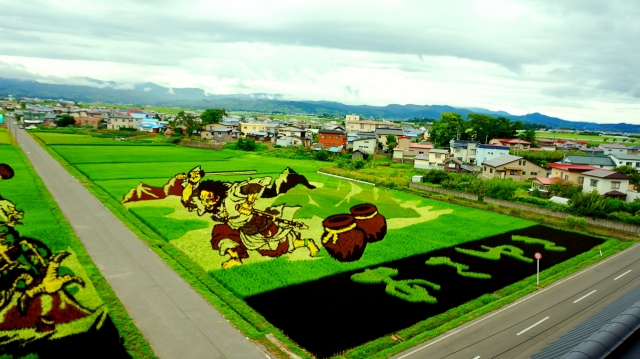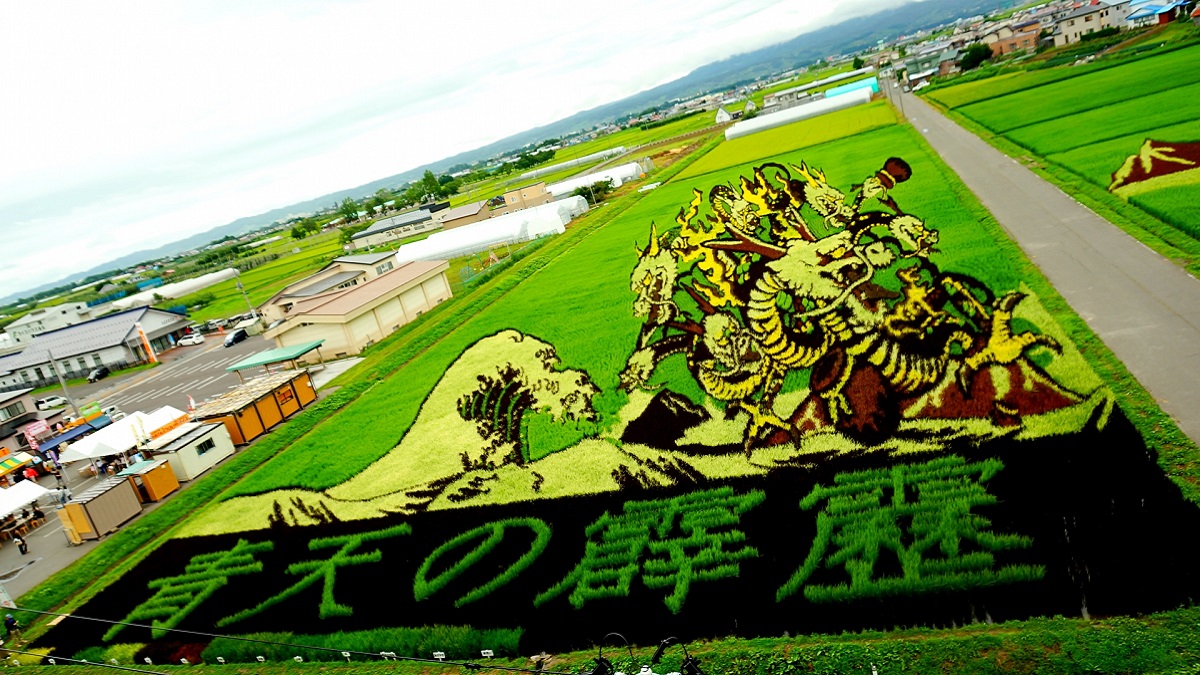Rice field art is a wonderful place where Japanese beauty and art harmonize with nature.
This fascinating project uses a rice field as a canvas and plants different colored rice plants to create giant pictures and letters.
Since its beginnings in Inakadate Village, the fusion of Japanese landscape and art has attracted attention across Japan and internationally.
In this article, let’s explore the charm of rice field art, how to enjoy it in places like Inakadate Village, and the story behind it. We will guide you to the magical world of rice field art.
Overview of “Rice Paddy Art”

Rice field art, which was born in Inakadate Village, started in 1993 as a village revitalization project.
This project was born from the unique idea of turning rice fields into canvases for art and creating beautiful works of art using the ears of rice. So
After that, in the 2010s, this art form rapidly spread and became so popular that a nationwide event, the National Rice Paddy Art Summit, was held.
The charm of rice field art in Inakadate Village
Rice field art in Inakadate Village is known for its beauty and uniqueness.
Inakadate Village’s rice field art is held in a rice field of about 1.5 hectares to the east of the village hall.
Furthermore, starting in 2012, the rice fields inside the roadside station Inakadate have also been set up as a venue, making it possible to enjoy even more diverse art.
The rice used in this artwork is of various varieties, with modern edible rice varieties used for the background and purple, yellow or brightly colored ornamental rice varieties chosen for the artwork. Masu.
This creates colors such as green, yellow-green, dark purple, yellow, white, orange, and red, and the entire rice field is colored with beautiful colors.
Rice field art design
The appeal of this art form is that the designs are designed with perspective in mind, assuming that they are viewed diagonally from above.
By combining this design with the color of the rice ears, a beautiful work of art is created.
Plant rice of different colors
At this location, rice fields are used as a giant canvas, and rice plants of different colors are planted according to a designed pattern. The result is a stunningly beautiful landscape.
The varieties and colors of rice as of 2019 are:
- “Tsugaru Roman” and “Asayuki” (green)
- “Murasaki Daikoku” (purple)
- “Odaikoku” (yellow)
- “Midori Daikoku” (dark green)
- “Yukiasobi” (white)
- “Akane Asobi” (orange)
- “Beni Asobi” (Red)
- “Shihonami” (purple ears)
- “Ahonami” (ears are red)
- “Shirahonami” (white ears)
There are 11 types and 7 colors.
Events where you can participate in rice field art are also held.
Furthermore, events are held where you can participate in rice planting and harvesting, and many people actually participate in rice field art. The activities at this place indicate that it is worth visiting.
Best time to see
The best time to see them is from mid-July to mid-August. From September to October, when harvest approaches, the color of the rice ears and leaves begins to fade.
basic information
| Name | Rice field art ■Location ① 1st Rice Paddy Art (Inakadate Village Observation Deck) 123-14F Inakadate Nakatsuji, Inakadate Village, Tsugaru District ②Second Rice Paddy Art (Yayoi no Sato Observatory) Takahi Izumi, Inakadate Village, Minamitsugaru District ■Business hours 9:00~17:00 ■Fees Adults: 300 yen each Children: 100 yen each ■Parking lot Parking available ■Inquiries TEL:0172-58-2111(extension 242, 243) FAX:0172-58-4751 ■Website inakadate-tanboart.net |
| Map |
SNS posting(#田んぼアート)
Find and make reservations for nearby restaurants
Find a good restaurant and have the best tour!


Comments